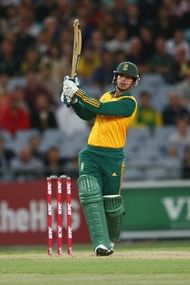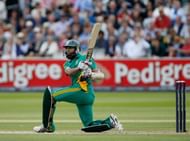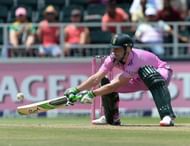It is a side that should have won more ICC trophies across the game’s shorter formats. Given the firepower in all three departments, the South African national team is a very well-balanced squad, boasting of some of the finest names in the business. Yet, in crunch stages, something affects their psyche – resulting in heartache and despondency.
The yellow-and-green jersey-clad warriors will return to the Indian subcontinent for yet another showpiece event – the World Twenty20 championship. As of now, they are saddled with a problem of plenty. Their move to bring in more all-rounders has paid off well in the recently concluded T20 series against England.
Also, a change of guard at the top worked wonders in the Johannesburg game, as the Proteas coasted to a solid 9-wicket victory over the hapless English.
This makes you wonder: how does the Rainbow Nation deal with a top order conundrum now in place? Who plays in which spot? Which player must make way for the other so that the balance remains, and the team coasts to a title win – their first ICC triumph since 1998 – on foreign soil?
To answer these queries, we take a look at the three members in question: AB de Villiers, Hashim Amla, and young wicket-keeper Quinton de Kock.
Quinton de Kock: Youthful exuberance
He is only 23 years old, and has already made three-figure knocks a habit in One-Day Internationals. However, Quinton de Kock’s performance in the T20 International arena has been, for lack of a better word, average – by his standards.
513 runs in 22 international games with a strike rate of 121.46 do not do justice to the skills and talent of a man who possesses youthful exuberance. Even during his stint with the Delhi Daredevils and the Sunrisers Hyderabad in the IPL, he wasn’t getting the quick starts that have become a trademark of his game.
The fact that his reflexes are really sharp, combined with his audacious strokeplay and ability to play the big shots, might go in his favour at least during the initial stages of the tournament. However, a lack of game time and recovery from a knee injury might lead to the team management reconsidering their decision.
Verdict: South Africa should allow the southpaw to play in the league stages at least, so he gets valuable time in the middle. If he is able to sustain the tempo, he might become a permanent fixture in the side for the whole tournament.
Hashim Amla: Solid and reliable, but a tad slow
The former Test skipper combines elegant strokeplay with a fantastic temperament, and has lent an aura of solidity at the top of the batting line up for many months now. However, most pundits feel his game is ideal only for the longest format, and only grudgingly acknowledge his suitability for ODIs.
There is some truth to this school of thought. For one thing, Amla does get bogged down when bowlers probe him relentlessly on a middle-and-off-stump line. Secondly, he hasn’t been able to play spin on the subcontinent as well as he did on earlier tours. And finally, his ability to quickly rotate the strike is also not quite up to the mark of late.
I’m saying this despite the fact that the bearded right-hander smashed a rapid, stroke-filled 69 at Johannesburg against England recently. While that track favoured the batting side, no team will get to enjoy similar comforts on the dust bowls that the Indian pitches are known to be. A question mark still remains over his place, though.
Verdict: I’d go with Amla for the whole tournament. If South Africa lose a few quick wickets, he can stabilize the innings, allowing the hitters down the order to pick it up from there.
AB de Villiers: Explosively innovative
There isn’t much to say about Abraham Benjamin de Villiers. He loves playing in India – the stands reverberating with chants of “ABD! ABD! ABD!” during the IPL and on South Africa’s international tours are evidence enough of the immense respect he commands.
Blending rapid running between the wickets with a complete 360-degree strokeplay that borders on innovative and sometimes bizarre, the Pretorian run machine is always the prized scalp for any opposition. If he plays as opener, and departs early, I would estimate that South Africa’s chances of chasing or putting up a winning total are reduced by forty to fifty percent.
I’ll choose to have AB play at the No. 3 slot. The reason is simple: at one-down, the maverick batsman can control the game completely from that point, instead of coming in further down and only getting ten or fifteen deliveries to score runs. At crucial stages, he can come in to open the innings if required.
Verdict: I would play AB de Villiers at No. 3. In case either opener suffers an injury or loss of form, he can start the innings with his customary free-flowing approach.
Summary
The roles are clearly defined for each player in the top order. South Africa’s best bet in the league stages will be to open with Quinton de Kock and Hashim Amla. For knockout stages, either man can drop down to No. 3 in order for ABD to showcase his wares.
There would still be finishers down the order, but de Kock, Amla and de Villiers must be the Proteas’ top three going into the tournament.
Looking for fast live cricket scores? Download CricRocket and get fast score updates, top-notch commentary in-depth match stats & much more! 🚀☄️



